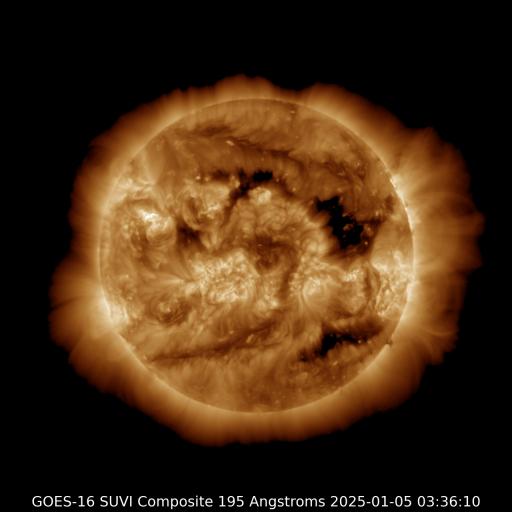Viewing archive of Thursday, 31 August 2006
Solar activity report
Any mentioned solar flare in this report has a scaling factor applied by the Space Weather Prediction Center (SWPC). Because of the SWPC scaling factor, solar flares are reported as 42% smaller than for the science quality data. The scaling factor has been removed from our archived solar flare data to reflect the true physical units.
Report of Solar-Geophysical Activity 2006 Aug 31 2309 UTCPrepared by the NOAA © SWPC and processed by SpaceWeatherLive.com
Joint USAF/NOAA Report of Solar and Geophysical Activity
SDF Number 243 Issued at 2200Z on 31 Aug 2006 IA. Analysis of Solar Active Regions and Activity from 30/2100Z to 31/2100Z: Solar activity was at very low levels today. Region 905 (S08W67) produced multiple B-class flares during the period. Region 906 (S09W51) is a rapidly emerging, newly numbered region. This region produced a B7 x-ray event that occurred at 31/1748Z and had an associated Type IV radio emission in addition to a Tenflare with a peak flux of 740 sfu.IB. Solar Activity Forecast
Solar activity is expected to be at
very low levels. There is a chance for an isolated C-class flares
from both Regions 905 and 906.
IIA. Geophysical Activity Summary 30-2100Z to 31-2100Z
The geomagnetic field was at quiet to unsettled levels.
IIB. Geophysical Activity Forecast
The geomagnetic field is
expected to be at predominantly quiet to unsettled levels. A chance
for active to isolated minor storm conditions are possible on 03
September due to a recurrent coronal hole.
III. Event Probabilities 01 Sep to 03 Sep
| Class M | 01% | 05% | 15% |
| Class X | 01% | 01% | 01% |
| Proton | 01% | 01% | 01% |
| PCAF | green | ||
IV. Penticton 10.7 cm Flux
Observed 31 Aug 083 Predicted 01 Sep-03 Sep 090/095/090 90 Day Mean 31 Aug 077
V. Geomagnetic A Indices
Observed Afr/Ap 30 Aug 005/006 Estimated Afr/Ap 31 Aug 005/005 Predicted Afr/Ap 01 Sep-03 Sep 004/005-004/010-012/020
VI. Geomagnetic Activity Probabilities 01 Sep to 03 Sep
| A. Middle Latitudes | |||
|---|---|---|---|
| Active | 15% | 15% | 25% |
| Minor storm | 01% | 01% | 10% |
| Major-severe storm | 01% | 01% | 05% |
| B. High Latitudes | |||
|---|---|---|---|
| Active | 20% | 20% | 35% |
| Minor storm | 05% | 05% | 15% |
| Major-severe storm | 01% | 01% | 10% |
All times in UTC
Current data suggests there is a slight possibility for aurora to appear at the following high latitude regions in the near future
Norilsk, VorkutaLatest news
Latest forum messages
Incoming & Unnumbered Active Regions 1677AR4048 126New satellites - Proba-3, PUNCH, SWFO-L1, GOES-U/19 47AR 4054 21Unspecified geomagnetic activity 2229
More topicsSupport SpaceWeatherLive.com!
A lot of people come to SpaceWeatherLive to follow the Sun's activity or if there is aurora to be seen, but with more traffic comes higher server costs. Consider a donation if you enjoy SpaceWeatherLive so we can keep the website online!

Latest alerts
15:15 UTC - Geomagnetic activity
Minor G1 geomagnetic storm (Kp5) Threshold Reached: 14:59 UTC
06:30 UTC - Type II Radio Emission
Begin Time: 08/04/2025 05:53 UTC Estimated Velocity: 456km/sec.
05:15 UTC - Hemispheric Power Index
The OVATION model predicts the Hemispheric Power Index to reach 50GW at 06:02 UTC
00:55 UTC - Coronal hole
A southern hemisphere coronal hole is facing Earth. Enhanced solar wind could arrive in ~3 days
Monday, 7 April 2025
20:45 UTC - Geomagnetic activity
Active geomagnetic conditions (Kp4) Threshold Reached: 20:39 UTC
Space weather facts
| Last X-flare | 2025/03/28 | X1.1 |
| Last M-flare | 2025/04/05 | M1.0 |
| Last geomagnetic storm | 2025/04/06 | Kp5 (G1) |
| Spotless days | |
|---|---|
| Last spotless day | 2022/06/08 |
| Monthly mean Sunspot Number | |
|---|---|
| March 2025 | 134.2 -20.4 |
| April 2025 | 151.3 +17.1 |
| Last 30 days | 135.2 -4.5 |





